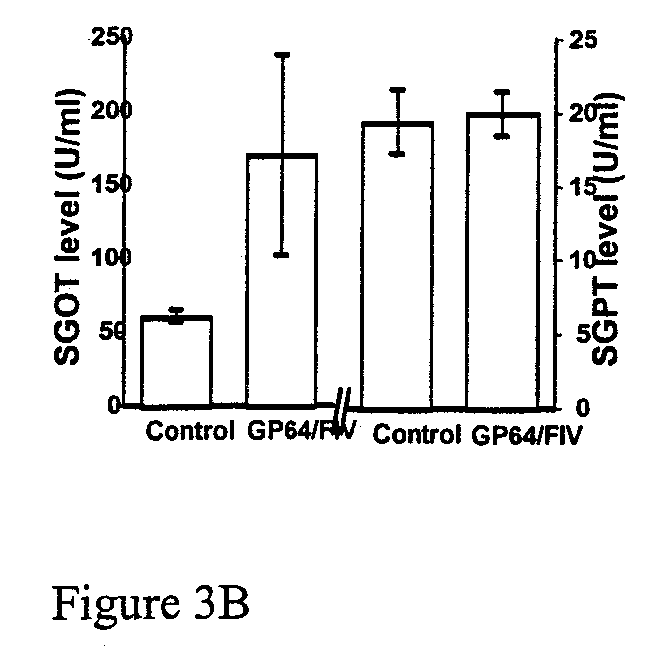Methods for producing and using in vivo pseudotyped retroviruses
a technology of pseudotyped retroviruses and vectors, applied in the direction of peptide sources, dsdna viruses, genetic material ingredients, etc., can solve the problem of limited vivo application of viral vectors
- Summary
- Abstract
- Description
- Claims
- Application Information
AI Technical Summary
Benefits of technology
Problems solved by technology
Method used
Image
Examples
example 1
Gene Transfer to Human Airway Epithelia In Vitro Using FIV Pseudotyped with Baculovirus GP64
[0158]Primary cultures of human airway epithelial cells (Karp P H et al., Methods Mol Biol 2002; 188:115-37) were transduced with pseudotyped FIV-vector by diluting vector preparations in media to achieve the desired MOI and 100 μl of the solution was applied to the apical surface of airway epithelial cells. The vectors were produced using the methods of Johnston et al., J Virol. 1999 73:4991-5000 and Wang et al., J Clin Invest. 1999 104:R55-62. After incubation for 4 hours at 37° C., the virus was removed and cells were further incubated at 37° C., for 4 days. To infect airway epithelia with pseudotyped FIV-vector from the basolateral side, the cell culture insert containing the airway epithelia was turned over and the virus was applied to the basolateral surface for 4 hours in 100 μl of media (Wang G et al., J Clin Invest 1999; 104:R49-R56; Wang G et al., J Virol 1998; 72:9818-982).
[0159]Fo...
example 2
Gene Transfer to Mouse Liver Using FIV Pseudotyped with Baculovirus GP64 Envelope
[0162]Gene transfer to the liver has potential clinical applications for many diseases. The present inventors evaluated the liver transduction properties of the FIV pseudotyped with GP64. For systemic vector delivery to the liver, C57BL / 6 mice received the GP64 pseudotyped FIV vector intravenously via the tail vein using methods as previously described (Stein C S et al., Mol Ther 2001; 3:850-6; Kang Y et al., J Virol 2002; 76:9378-9388). Briefly, one month old mice were injected via tail vein on two consecutive days in a volume of ˜0.3 ml. The mice received either control buffer or 2.4×107 TU of GP64 / FIV vector expressing nuclear-targeted β-galactosidase. On day one postinjection, the present inventors obtained blood samples from the retro-orbital plexus and assayed serum samples for the levels of glutamic oxalacetic transaminase (SGOT) and glutamic pyruvic transaminase (SGPT). At three weeks postinject...
example 3
In Vivo Gene Transfer to the Central Nervous System with Baculovirus GP64
[0166]Gene transfer to the CNS has applications for a number of inherited and acquired neurodegerative conditions (Brooks et al., Proc Natl Acad Sci USA 2002; 99:6216-21). For CNS gene transfer, mice were anesthetized with ketamine-xylazine (ketamine, 100 mg / kg; xylazine, 10 mg / kg) as previously described (Brooks et al., Proc Natl Acad Sci USA 2002; 99:6216-21). A total of 5 μl of GP64-pseudotyped vector containing 5×105 TU was stereotactically injected into the striatum at coordinates +2 mm lateral and 0.4 mm rostral to the bregma and 3 mm deep by using a 26-gauge Hamilton syringe driven by a microinjector (Micro 1; World Precision Instruments, Sarasota, Fla.) at 0.5 μl per min. Alternatively, a similar volume of vector was injected into the lateral ventricle. At 3 weeks postinjection, mice were sacrificed and perfused with 2% paraformaldehyde in PBS. The brains were postfixed overnight at 4° C. and cryoprotec...
PUM
| Property | Measurement | Unit |
|---|---|---|
| time | aaaaa | aaaaa |
| time | aaaaa | aaaaa |
| volume | aaaaa | aaaaa |
Abstract
Description
Claims
Application Information
 Login to View More
Login to View More - R&D
- Intellectual Property
- Life Sciences
- Materials
- Tech Scout
- Unparalleled Data Quality
- Higher Quality Content
- 60% Fewer Hallucinations
Browse by: Latest US Patents, China's latest patents, Technical Efficacy Thesaurus, Application Domain, Technology Topic, Popular Technical Reports.
© 2025 PatSnap. All rights reserved.Legal|Privacy policy|Modern Slavery Act Transparency Statement|Sitemap|About US| Contact US: help@patsnap.com



